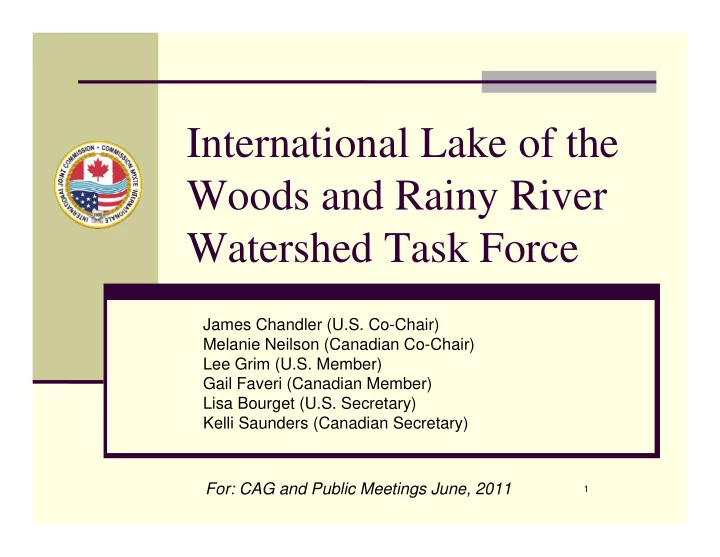

International Lake of the Woods and Rainy River Watershed Task Force James Chandler (U.S. Co-Chair) Melanie Neilson (Canadian Co-Chair) Lee Grim (U.S. Member) Gail Faveri (Canadian Member) Lisa Bourget (U.S. Secretary) Kelli Saunders (Canadian Secretary) For: CAG and Public Meetings June, 2011 1
Overview Task Force - provide brief overview: • Task Force directive and approach – Priority issues in the watershed – Task Force observations – Recommendations for improved binational governance – Your feedback • Do these recommendations seem reasonable for this – watershed? Do you see issues falling through the cracks? – 2
Reference of June 17, 2010 recommend binational governance structures or mechanisms for the Lake of the Woods and Rainy River watershed identify priority issues or activities to be addressed identify the IJC's potential role in binational management in the basin align with IJC’s International Watersheds Initiative respect existing treaties, orders and jurisdictional authorities already in place Task Force undertook extensive engagement in order to develop recommendations 3
The Watershed
Priority Issues in the Watershed Aboriginal representation Nutrient enrichment and harmful algal blooms Effects of climate change Impacts of water level regulation Watershed development Invasive species Communication 5
Observations Lack of Communication Unawareness of issues upstream and downstream, across the border Lack of understanding of how to engage in decision-making across watershed However, annual Lake of the Woods Water Quality Forum an excellent venue for sharing information Shortfalls in governance Lack of aboriginal representation: impacting everyone in watershed, as well as decision-making ability IMA requires stable leadership and renewed commitment Lack of data and science regarding source of water impairment throughout watershed; limited long-term core monitoring No watershed plan for whole watershed Multiple watershed plans in U.S.; lacking in Canada Resource commitments to any strategy once defined
Themes of our Recommendations International International Watershed Watershed Initiative Board: Initiative Board: Watershed Vision Watershed Vision Strengthen Strengthen Leadership/ Leadership/ Coordinate Coordinate Review Lake of the Review Lake of the Research Research Woods Regulation Woods Regulation via International via International Improved Improved Improved Multi-Agency Multi-Agency Binational Binational Working Group Binational Working Group Management of Management of Management of LOW/RR LOW/RR LOW/RR Leaders Conference Strengthen Leaders Conference Strengthen to Tie Community to Tie Community Science to Policy Involvement in Science to Policy Involvement in and Planning Watershed Decisions and Planning Watershed Decisions
RECOMMENDATIONS Recommendations to Improve Binational Governance CDN Government continue efforts to resolve land and flooding claims, partner with First Nations and Métis in watershed governance CDN and US Governments issue an anticipated timetable early after receiving report from IJC for considering its recommendations IJC to review governments’ progress in addressing recommendations three years after submitting report Appointment process to LWCB/ILWCB be streamlined; CDN Government ensure adequate budget for Secretariat to support bi-national activities (including with IJC boards); ILWCB provide courtesy copy of report annually to IJC
RECOMMENDATIONS Create an International Watersheds Initiative Board under the IJC Merge IRLBC and IRRWPB into a watershed Board Continue water-level regulation mandate for Rainy and Namakan lakes Expand water quality mandate to include Lake of the Woods and boundary waters upstream of the Rainy River Provide alerting function for entire LoW-RR watershed Facilitate exchange of information for issues in watershed Review and update of bi-national alert levels in Rainy River Review existing monitoring – sufficient to assess future impacts? Track climate change indicators and Alien Invasive Species presence/spread/mitigation efforts Monitor progress against IMA-developed nutrient loading allocation targets
Strengthen Leadership/Coordinate Research via RECOMMENDATIONS International Multi-Agency Working Group Purpose and Objectives for the Multi-Agency Working Arrangement would continue Leadership of the involved agencies to support and encourage timely completion of ongoing science Improve stability of IMA-WG: Secretary, Co-chairs Integrate the results of science to determine and apportion nutrient loadings for the entirety of Lake of the Woods Within the next six months, scope the effort required to design a joint core monitoring program
RECOMMENDATIONS Organize a Leaders Conference to Tie Science to Policy and Planning IJC to convene a special conference among elected federal, state, provincial and aboriginal leaders in and governing the watershed, as well as key Government agency officials, to discuss: Common vision for the watershed Shared goals and objectives Implementation strategies Need for a higher-level agreement
RECOMMENDATIONS Review of Lake of the Woods Regulation Canadian and US Government to issue a reference to the IJC to conduct a binational study to review water-level regulation impacts of Lake of the Woods (including Shoal Lake) and determine whether water level range still appropriate To consider: riparian interests shoreline erosion water quality wild rice harvesting navigation isostatic rebound
RECOMMENDATIONS Strengthen Community Involvement in Watershed Decision-Making IWI Board to: Include First Nations, Tribe and/or Métis member Enhance outreach and communication efforts Consider establishing a Citizen Advisory Group LWCB to: Include a local member from the watershed Enhance their outreach to include all relevant interests Provide more convenient opportunities to share information Establish a formal Advisory Committee for information, including traditional knowledge
Comments on report due by June 24th Final report to be submitted to IJC by July 15, 2011 Submit comments to the Task Force website: www.ijc.org/conseil_board/rainy_river_watershed …or directly to the Task Force Secretaries: Lisa Bourget, U.S. Co-Secretary (703) 407-9502 Kelli Saunders, Canadian Co-Secretary (807) 468-2732
Recommend
More recommend